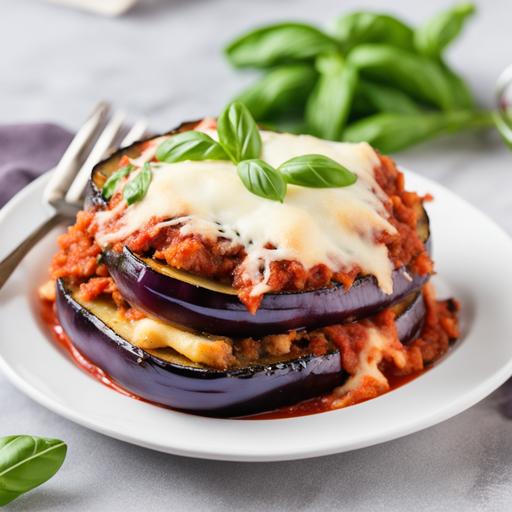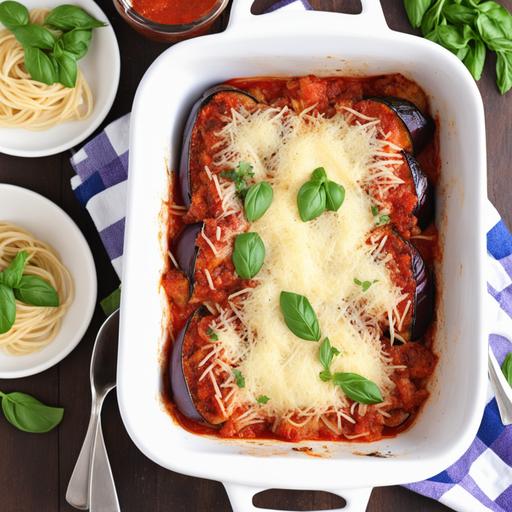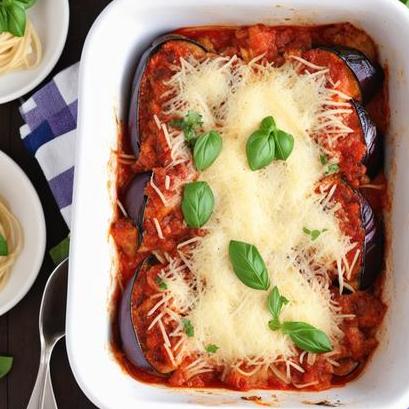
The Ultimate Eggplant Parmesan Oven Recipe: A Exquisite Delight
Are you a fan of Italian cuisine and looking to add some authentic flavors to your recipe repertoire? Look no further! In this comprehensive guide, we will delve deep into the world of eggplant Parmesan, a delectable dish that will leave your taste buds craving for more. From the food science behind this dish to culinary details, selections, cleaning, preparation, tips, variations, doneness checks, and everything in between, we’ve got you covered. So let’s dive in and discover the secrets to creating the perfect eggplant Parmesan!
Unveiling the Magic – The Food Science behind Eggplant Parmesan
Before we embark on this culinary journey, it’s crucial to understand the science behind this dish. Eggplant, a member of the nightshade family, holds a unique texture that needs to be managed correctly to ensure a successful outcome. Its porous nature readily absorbs flavors, making it ideal for savory dishes like eggplant Parmesan.
When cooked, eggplant releases water, which can potentially lead to a soggy final product. To mitigate this, we employ various culinary techniques to draw out the excess moisture from the eggplant and enhance its flavor. Additionally, the eggplant’s tender flesh, when combined with the richness of cheese and tomato sauce, creates a heavenly combination that chefs and home cooks alike adore.
Selection and Cleaning of the Perfect Eggplant
To start our journey, it’s vital to choose the best eggplants for our recipe. Look for eggplants that are firm, glossy, and heavy for their size. Avoid those with blemishes or wrinkled skin, as these may indicate overripe or spoiled eggplants.
Once you bring home your chosen eggplants, it’s time to clean them. Gently wash them under cool water and pat them dry with paper towels. Next, carefully remove the stem and use a vegetable peeler or a sharp knife to strip off the skin. Peeling the eggplant helps maintain a consistent texture in your dish, and it also enhances the flavor by minimizing any potential bitterness.
Preparation – Unleashing the Flavors

Now that our eggplants are ready, it’s time to prepare them for cooking. One popular technique to avoid a mushy final texture is salt-curing the eggplant. Slice the eggplant into rounds or lengthwise strips, whichever you prefer. Sprinkle salt generously on both sides of the eggplant and place the slices in a colander. This step draws out the excess moisture from the eggplant, resulting in a firmer, more flavorful dish.
Leave the salted eggplant in the colander for a minimum of 30 minutes, allowing the salt to work its magic. During this time, you may notice the eggplant releasing water. Rinse the slices with cold water to remove any excess salt, and pat them dry with paper towels. Your eggplant is now ready to be transformed into a culinary masterpiece.
Tips and Tricks for a Spectacular Eggplant Parmesan

Creating a top-notch eggplant Parmesan involves mastering a few tips and tricks. Here are some invaluable secrets to ensure your dish is a smashing success:
1. Breading Technique: To achieve a beautifully crispy exterior, using a breadcrumb mixture is essential. Create a breadcrumb blend by combining breadcrumbs with grated Parmesan cheese and a variety of herbs and spices. Dip each eggplant slice into beaten eggs and then coat it in the breadcrumb mixture, pressing gently to adhere the crust evenly.
2. Frying or Baking: Traditionally, eggplant Parmesan is prepared by frying the breaded slices until golden brown. However, to reduce the amount of oil used and achieve a healthier twist, baking the prepared eggplant slices is an excellent choice. Place them on a baking sheet lined with parchment paper and bake in a preheated oven until golden brown and crisp.
3. Layering is Key: The structural integrity of your eggplant Parmesan lies in the layering process. Alternate between layers of eggplant, tomato sauce, and cheese, ensuring each component is evenly distributed. This ensures a harmonious balance of flavors throughout the dish.
4. Cheese Selection: While mozzarella cheese is the classic choice for this dish, feel free to experiment with different varieties. Provolone, fontina, or even a sharp cheddar can add a unique twist to the traditional recipe. Remember, the cheese you choose plays a significant role in the final taste experience.
Recipe: Oven-Baked Eggplant Parmesan

Now that you are armed with the knowledge and techniques for creating an outstanding eggplant Parmesan, it’s time to share a radiant recipe that utilizes the oven-baking method. This approach ensures a healthier version without compromising on flavors. Gather the following ingredients:
-
2 large eggplants
-
1 cup of breadcrumbs
-
1/2 cup freshly grated Parmesan cheese
-
2 teaspoons dried Italian herbs (such as oregano, basil, and thyme)
-
Salt and pepper to taste
-
2 eggs, beaten
-
2 cups of your preferred marinara or tomato sauce
-
2 cups shredded mozzarella cheese
-
Fresh basil leaves for garnish
Step 1: Preparing the Eggplant
-
Preheat your oven to 375°F (190°C).
-
Peel the eggplants and slice them into 1/2-inch thick rounds.
-
Salt-cure the eggplant slices as previously described, allowing them to sit for 30 minutes.
Step 2: Breading and Baking
-
After rinsing and patting dry the salted eggplant slices, prepare a mixture of breadcrumbs, grated Parmesan cheese, dried herbs, salt, and pepper in a shallow dish.
-
In a separate shallow dish, beat the eggs until well combined.
-
Dip each eggplant slice into the beaten eggs, ensuring both sides are coated, then transfer it to the breadcrumb mixture, pressing gently to adhere the breadcrumbs evenly.
-
Place the breaded eggplant slices in a single layer on a baking sheet lined with parchment paper.
-
Bake in the preheated oven for approximately 20-25 minutes, or until the slices are golden and crisp.
Step 3: Assembling the Eggplant Parmesan
-
In a baking dish, spread a thin layer of tomato sauce on the bottom.
-
Add a single layer of the baked eggplant slices over the sauce.
-
Spoon additional tomato sauce on top of the eggplant, followed by a layer of mozzarella cheese.
-
Repeat the layering process until all the eggplant slices are used, ensuring the top layer is covered in sauce and cheese.
-
Cover the baking dish with aluminum foil and bake in the oven for approximately 25-30 minutes, or until the cheese is melted and bubbly.
-
Remove the foil and broil for an additional 2-3 minutes to achieve a golden brown crust.
-
Allow the dish to rest for a few minutes before garnishing with fresh basil leaves and serving.
Doneness Checks – Perfection at Every Bite

Determining whether your eggplant Parmesan is properly cooked is crucial to guarantee a delightful dining experience. Here are a few indicators to ensure your dish is appropriately done:
1. Texture: The eggplant slices should be tender but not mushy, allowing a light bite without extreme resistance.
2. Cheese Melting: The cheese on top should be melted, golden brown, and slightly bubbly.
3. Internal Temperature: Insert a food thermometer into the center of the dish to ensure it reaches an internal temperature of at least 165°F (74°C).
Exploring Variations – Elevating Your Eggplant Parmesan
While the classic eggplant Parmesan recipe is a culinary delight in itself, exploring different variations can add excitement to your creations. Here are a few ideas to inspire your culinary experiments:
-
Meaty Twist: Layer cooked ground beef or Italian sausage between the eggplant slices to add a hearty dimension to your dish.
-
Veggie Loaded: Amp up the vegetable quotient by adding layers of thinly sliced zucchini or roasted bell peppers between the eggplant slices.
-
Buffalo Style: Give your eggplant Parmesan a spicy kick by drizzling buffalo sauce over each layer and sprinkling crumbled blue cheese as a finishing touch.
Remember, eggplant Parmesan is a flexible canvas waiting for you to express your culinary creativity!
Avoiding Undercook and Overcook – Striking a Perfect Balance
Achieving the ideal balance between undercooked and overcooked eggplant Parmesan requires precision. Follow these guidelines to steer clear of these pitfalls:
-
Undercooked: If your eggplant Parmesan lacks tenderness and the eggplant slices are still firm, consider baking the dish for a few more minutes until the texture is just right.
-
Overcooked: An overcooked eggplant Parmesan may result in soggy and disintegrated eggplant. Ensure you are mindful of the recommended cooking times and avoid leaving your dish in the oven for too long. Monitoring the cheese layer’s color is a good indicator to prevent overcooking.
In Conclusion
With this extensive guide and a tantalizing oven-baked eggplant Parmesan recipe at your disposal, you are now equipped to conquer the world of Italian cuisine. Embrace the delightful science behind this dish, master the selection and cleaning process, employ essential tips and tricks, and experiment with variations to make this recipe truly your own. Remember, there’s nothing more rewarding than seeing your loved ones enjoy every scrumptious bite of your homemade eggplant Parmesan masterpiece. Bon appétit!
Sources
FAQS On Eggplant Parm Oven Recipe
What Ingredients Do I Need To Make Eggplant Parm In The Oven?
You will need eggplants, Italian breadcrumbs, eggs, flour, marinara sauce, fresh mozzarella cheese, and grated Parmesan cheese.
How Do I Prepare The Eggplants For The Oven?
Cut the eggplants into thin, even slices and sprinkle them with salt. Let them sit for 30 minutes to an hour to draw out excess moisture. Rinse and pat dry before coating them in flour, eggs, and breadcrumbs.
What Temperature Should I Set The Oven To?
Preheat your oven to 375°F.
How Long Does The Eggplant Parm Need To Bake In The Oven?
Bake the eggplant slices for 20-25 minutes until they are golden brown on the outside and tender on the inside. Assemble the eggplant parm with sauce and cheese and bake for an additional 10-15 minutes until the cheese is melted and bubbly.
Can I Make Eggplant Parm Ahead Of Time And Reheat It In The Oven?
Yes, you can make the eggplant slices ahead of time and store them in an airtight container in the fridge for up to three days before assembling and baking. You can also assemble the eggplant parm ahead of time, cover it with foil and refrigerate for up to two days before baking it in the oven. Reheat the leftovers in the oven at 350°F for 20-25 minutes until heated through.



